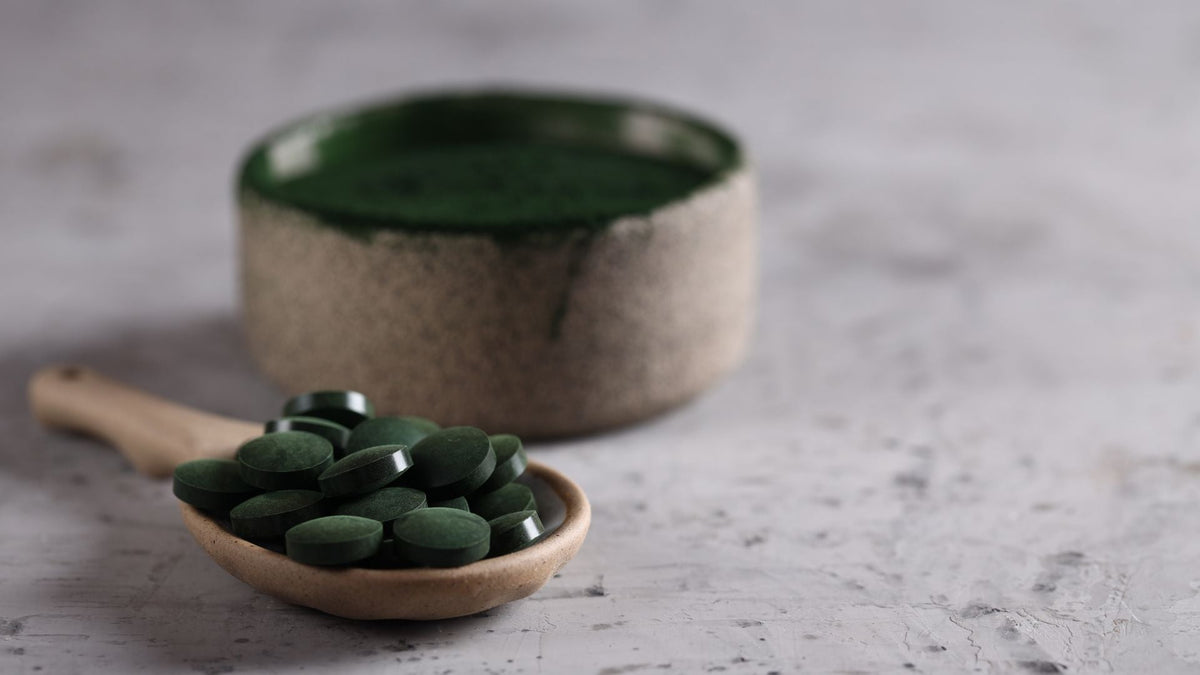
Spirulina Benefits: The Unique Vegan Superfood
|
Time to read 5 min
|
Time to read 5 min
What is spirulina, and what makes it so unique that many people call it a superfood? As it turns out, spirulina is a little green vegetable microorganism with many unique qualities. In this article, we will tell you everything you need to know about spirulina - what it is, what it is good for, and why and how to incorporate it into your diet. Let’s jump right in!
Spirulina is a type of blue-green algae that grows in or near mineral-rich waters and does not have ordinary leaves or roots. It grows in little coiled strands and is common in tropical lakes and shallow ponds. It was a significant food source for the ancient Maya and Aztec peoples of South America, and the Kanembu people of Chad cultivate it as a dietary mainstay right to this day. One of the world’s most nutritious and beneficial “superfoods,” spirulina is an ideal food source for human consumption. Spirulina contains an almost perfect balance of protein, including essential amino acids; it is easily digested, quickly assimilated, and satisfies hunger quickly. Far less bulk is needed than any other food, and it is naturally low in cholesterol, calories, fat, and sodium. It is cited as the most nutrient-rich of all known living foods and may very well be one of the original producers of oxygen on this planet.
Gram for gram spirulina is considered one of the most nutrient-dense foods on earth. A single tablespoon of spirulina provides 4g of protein, 20 calories, and a significant amount of vitamins B1, 2, and 3, iron, magnesium, iron, and potassium.
Spirulina provides impressive antioxidant and anti-inflammatory effects. It can prevent oxidative damage, fight free radicals, and inhibit the production of inflammatory signaling molecules.
Spirulina contains a compound called phycocyanin, an antioxidant that fights off anything that could cause damage to your cells.
A dose of 4.5 grams of spirulina per day reduced blood pressure in individuals with normal levels. Incorporating spirulina in your diet can significantly lower the possibility of major diseases, like heart attack, stroke, etc.
Spirulina is full of nutrients, and a tablespoon has 4g of protein and only 20 calories. Additionally, it also contains an amino acid called l-phenylalanine, which is linked to suppressing appetite, and helping people to reduce food intake.
Spirulina has antioxidant properties that can help athletes and physically active individuals. In studies, spirulina improved muscle strength and endurance. Additionally, it also increased the time it took for people to become fatigued.
Spirulina helps treat and get rid of yeast infections. It attracts candida cells and can get them out of the body.
Two grams of spirulina daily can prevent allergies from pollen, dog hair, grass, or other environmental factors. In addition, it can reduce and even eliminate allergy symptoms like a runny nose or itchy eyes.
Spirulina is fantastic for vegans since it contains between 60-70% protein, which is higher than pretty much any other food. It’s a complete protein with all the essential amino acids required for ultimate health. In addition, it’s a type of kelp, so it’s 100% vegan and is extremely low in fat. Vegans often turn to tofu, quinoa, legumes (such as beans and lentils), and wheat gluten protein (a.k.a seitan) when looking for their protein. Spirulina can add an incredible boost of protein to your diet as a supplement to these foods. It is an excellent alternative, especially for gluten or soy intolerance. In addition to being a fantastic protein source, spirulina is packed with iron and is said to increase energy and lower cholesterol.
If you start looking online to buy spirulina, you might find that there are two types - blue spirulina and green spirulina. Blue spirulina is derived from blue-green algae, Arthrospira platensis. Phycocyanin is a pigment that gives the green spirulina a slightly bluish hue. To make blue spirulina, the water-soluble antioxidant phycocyanin is extracted from the spirulina and then sold as a blue powder. Phycocyanin is only found in spirulina and a few other species of blue-green algae.
Spirulina is typically sold as a dark-green powder or pills. To take it, you can stir a teaspoon of spirulina powder into a glass of water. Mix well, and then drink it! Just a small amount will color the water into deep green color.
While there’s no standard spirulina dosage, most studies have found a beneficial effect when consuming between 1 and 10 grams daily. For reference, one tablespoon of spirulina is around 7 grams.
While spirulina is generally safe, there are a couple of downsides that it’s good to be aware of. First, it is best to avoid the green algae, if:
If you have those or similar conditions, it is best to be on the safe side and reach out to a doctor before using it.
If you’ve tried spirulina, you will know it doesn’t have the most delicious taste ever. On its own, spirulina tastes like seaweed and is sometimes sulfuric or fishy. Luckily, there are many great & tasty ways to incorporate spirulina into your diet. Here are a couple of ideas:
To ensure that you are getting the best quality spirulina, look for labels that include terms such as “spirulina,” “spirulina platensis,” or “Arthrospira platensis.” If getting tablets, ensure that the content is at least 98% and that they must not contain any preservatives or artificial colorings. A couple of great options include:
With its numerous health benefits for humans and the planet, this little blue-green algae is more of a miracle than a supplement. Add a spoonful of spirulina powder to your next super-smoothie, and let the nutrition seep into every cell.
Vegancuts curates monthly premium-quality Discovery Snack Boxes – include carefully selected products and brands that are always 100% vegan.
From vegan mac and cheese and delicious vegan chocolate to avocado chips, hummus crackers, and superfood smoothies.








